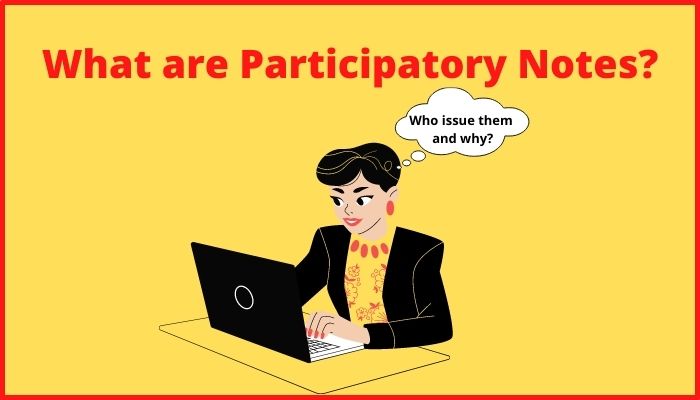Some factors aren’t directly related to every investor. However, they directly affect performance of the Stock market. One of them is P-Notes. Do you know what are participatory notes? If your answer is no, let’s discuss them in detail with examples.
Table of Contents
What are Participatory Notes?
Participatory Notes or P-Notes are monetary tools used by individuals or hedge funds to trade in Indian equities without registering with the Securities and Exchange Board of India (SEBI). P-Notes or pns are part of a category of investments known as Offshore Derivative Investments (ODIs).
The largest issuers of these notes are Citigroup (C) and Deutsche Bank (DB). Dividends and capital gains from the securities are returned to the investors.
Hedge funds acting through P-Notes can create economic volatility in India’s exchanges, hence Indian authorities are typically opposed to them.

Example
Via a set of phases, P-Notes can be utilised to buy any Indian security desired by a buyer. An investor deposits money with a licensed foreign institutional investor (FII), including HSBC or Deutsche Bank, in the United States or Europe.
The bank is then notified of the Indian security or securities that the investors desire to buy. The customer transfers funds to the FII account, and the FII provides participatory notes to the customer and purchases the actual share or equities in the appropriate volumes from the Stock market.
Description of Participatory Notes
This technique allows unregistered foreign investors to buy Indian stocks without having to register with the Indian securities regulator. These investments benefit India as well.
They give the Indian capital market exposure to quick liquidity. Foreign institutional investors are subject to less regulations than domestic institutional investors due to the short-term character of their investments.
These investors exchange participatory notes to participate in Indian stock markets while avoiding the lengthy legal authorization.
Advantages of Participatory Notes
- By endorsement and delivery, P-Notes can be easily exchanged internationally.
- They are attractive because investors may hold positions in Indian markets discreetly, and hedge funds may operate secretly.
- Some companies invest in participatory notes to take benefit of tax regulations in specific nations.

Disadvantages of Participatory Notes
- Because of the secrecy, Indian authorities have trouble identifying the original and final owners of P-Notes.
- As a consequence, large quantities of unaccountable funds enter the economy via participatory notes.
- This unregistered money transfer has triggered several red flags.
Regulatory for P-Notes
The Securities and Exchange Board of India (SEBI) has no authority over participatory note trading. Despite the fact that international institutional investors are required to enroll with the Indian regulatory board, there is no record of participation notes trading between foreign institutional investors.
Officials are concerned that this approach will result in the P-Notes being used for financial fraud or other criminal purposes.
The Special Investigation Team (SIT) wants stronger compliance procedures for the selling of participatory notes because of this difficulty to track funds.
The Special Investigation Unit (SIT) is a specialist team of officials in Indian law enforcement who have been prepared to examine major incidents.
Participatory notes example
The government indicated in October 2007 that it was exploring trying to put a stop to participation note trading. The news prompted the Sensex index to lose 1,744 points throughout the day’s trading session, a decline of more than 8% at the time.
This market turbulence arose as a result of investor and government concerns that limiting the use of P-Notes would have a direct impact on the Indian economy.
This is because foreign institutional investors contribute to the expansion of India’s economy, industry, and capital markets, and tighter regulations would create difficulties for foreign investment to access the market
Current Law
Regulatory judgement continues to be a concern to participatory notes. P-Notes cannot take any derivative holdings in Indian markets for causes other than hedging, according to Indian regulators.
According to Economic times , the strict regulatory interference prompted P-Note investments to fall during 2018, eventually reaching a more than 9-1/2 year low in November 2018.
In December 2018, nevertheless, investments rebounded as officials eased a few of the more tough criteria.

Conclusion
The P-Note have some great advantages in terms of providing liquidity to the stock market. However, They come with some risk of unaccountable money which can create instability.
This is all from outside regarding it. Although, if you have any doubts you can just comment below.
Other Interesting blogs related to p notes
Difference between Commercial Paper and Certificate of Deposit
Difference Between Equity Shares and Preference Shares
Difference between Nifty and Sensex
FAQ
Are p-notes banned in India?
No, P-notes are not banned in india. any oversea investor can invest via p-notes in india.
participatory notes are issued by?
Participatory notes are issued by foreign institutional investors.
Participatory notes are associated with
Participatory notes are associated with foreign institutional investors.
Who introduced participatory notes in India?
Securities and Exchange Board of India (SEBI) introduced participatory notes in India.
Participatory Notes in Hindi
पार्टिसिपेटरी नोट्स या पी-नोट्स मौद्रिक उपकरण हैं जिनका उपयोग व्यक्तियों या हेज फंड्स द्वारा भारतीय प्रतिभूति और विनिमय बोर्ड (सेबी) के साथ पंजीकरण के बिना भारतीय इक्विटी में व्यापार करने के लिए किया जाता है। पी-नोट्स या पीएनएस निवेश की एक श्रेणी का हिस्सा हैं जिन्हें ऑफशोर डेरिवेटिव इन्वेस्टमेंट (ओडीआई) के रूप में जाना जाता है।

